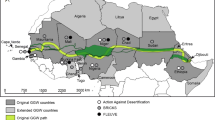Abstract
Japan’s national park system constitutes a potentially viable mechanism for securing local community participation and building stakeholder consensus for sustainable park management, although the potential of this system is yet to be fully maximized. This article gives an overview of the system of protecting natural resources in Japan, focusing on the national park system. Parks are managed by zoning and regulation, which is unique in that land is not “set aside” for nature conservation, but designated as national park wherever the need to preserve “scenic beauty” has been recognized, regardless of land ownership or land use. Although resource conservation under this system has been problematic, it has advantages, especially in terms of community participation. This article demonstrates that in order to reach the system’s potential, the park authority must act as coordinator of stakeholders and facilitator of bottom-up approaches to decision-making. In order to do this, steps that must be taken include the following: identifying the various stakeholders in park management and defining the “local community”; clarifying the roles and responsibilities of each stakeholder; and supporting consensus-building among stakeholders regarding the objectives and long-term vision of each park. By taking these steps, it would be possible to build a park management system that overrides government boundaries and involves local communities. This will enable the park authority to address the challenges facing Japan’s complex system of conserving natural resources, and move towards sustainable management of natural resources in Japan.
Similar content being viewed by others
Literature Cited
Agency for Cultural Affairs, Japan. 2003. Website on protection of cultural properties: http://www.bunka.go.jp/1hogo/frame.asp{0fl=list&id=1000000097&clc=1000000033 9.html
K. Bansho (2002) ArticleTitleShizenkoenho no ichibu kaisei ni tsuite (On partial amendments to the Natural Parks Law) Kokuritsu Koen (National Parks) 603 5–10
R. W. Butler S. W. Boyd (Eds) (2000) Tourism and national parks: Issues and implications Wiley Chichester
D. Evans (1997) A history of nature conservation in Britain EditionNumber2 Routledge London
D. A. Fennell (1999) Ecotourism: An introduction Routledge London
Forestry Agency, Japan. 1998. Japan: In-depth country study. Asia-Pacific Forestry Sector Outlook Study Working Paper Series. Working Paper No. APFSOS/WP/15, FAO, Available at ftp://ftp.fao.org/docrep/fao/W8301E/W8301E00. pdf
Forestry Agency, Japan. 2001. Website on laws related to the Basic Law on Forest and Forestry. Available at http://www.rinya.maff.go.jp/seisaku/kihonhou/kihonhou.html
Forestry Agency, Japan. 2003. Website on the natural environment in national forests: http://www.kokuyurin.maff. go.jp/Kokuyu_index_Natural.html
M. J. B. Green J. Paine (1997) State of the world’s protected areas at the end of the twentieth century World Conservation Monitoring Centre Cambridge, UK
T. Hatakeyama (2001) Shizenhogoho kougi (Lectures on nature protection law) Hokkaido University Press Sapporo, Japan
T. Ishikawa (2001) Nihon no shizen hogo: Oze kara Shiraho, soshite 21 seiki he (Nature conservation in Japan: From Oze to Shiraho and to the 21st century) Heibonsha Limited, Publishers Tokyo
N. Kato (2000) Nihon no Kokuritsukoen (Japanese national parks) Heibonsha Limited, Publishers Tokyo
M. Kato (2001) ArticleTitleKokuritsukoennai no tochishoyusha ha koenriyousha wo haijo dekiruka?—kokuritsukoen toshiteno shiyuchi riyo no genkai to kadai (Can landowners of national parks remove park users?—Limits to and challenges of designating privately owned land for use as national park) Yokohama International Economics Law 9 IssueID3 121–143
M. Kato (2003) ArticleTitleShizenkoen seido no aratana tenkai to kadai—Riyochouseichiku wo rei toshite (new developments and challenges of the natural parks system: Taking the example of utilization regulation zones) Kokuritsu Koen (National Parks) 618 8–10
S. Minami (2002) Shizen kankyo hozen souzo housei: Jizokukano na kaihatsu no tameno teian (Laws and regulations for the conservation and restoration of natural environment: Recommendations for sustainable development) Hokuju Publications Tokyo
MoE (Ministry of the Environment, Japan). 2001. For coexistence of people and nature: Nature conservation in Japan. Nature Conservation Bureau, Ministry of the Environment, Tokyo, 45 pp
MoE (Ministry of the Environment, Japan). 2002. Shizenkoenho no ichibu wo kaiseisuru houritsu ni tsuite (Regarding the amendments to parts of the Natural Parks Law). Kankyo (Environment) October:6-12
NACS-J (Nature Conservation Society of Japan). 2000. Yutakana shizen, fukai fureai, patonashippu—21 seiki no kokuritsukoen no arikata wo kangaeru (Rich nature, deep interactions, and partnership: Considering national parks in the 21st century). Report No. 88. NACS-J, Tokyo
InstitutionalAuthorNameNPAJ (National Parks Association of Japan) (2004) Shizen koen no tebiki (Guide to natural parks) National Parks Association of Japan Tokyo
InstitutionalAuthorNameNPF (National Parks Foundation) (2003) Renja no paionia tachi (Pioneer rangers) National Parks Foundation Tokyo
N. Okuda (2002) ArticleTitleNihon no shizenkoen, sekaiisan to ekotsurizumu (Japanese natural parks, world heritage and ecotourism) Science Journal (KAGAKU) 72 IssueID7 718–719
Sekine T., and M.Yoshida. 2003. Nihon no Shizenhogoho no Genjo to Kadai (The existing laws on nature conservation in Japan and their problems). Pages 15–30 in Seibutsugaku kara mita Yasei Seibutsu no Hogo to Houritsu (Laws on protection of wildlife from an ecological perspective). Kodansha Ltd., Tokyo.
Seta, N. 2002 “Ikitai” to omowaseru miryoku (Attractions that make people want to go). Pages 14–15 in Kankogaku ga wakaru (Easy tourism studies). AERA MOOK 81 Asahi Shimbun Publishing, Tokyo.
Acknowledgments
Thanks are due to all those who inspired me to write this article, in particular Dr. Mineo Kato of Yokohama National University, by stressing the uniqueness of the Japanese system and by providing me with background information. Much appreciation is also expressed to the reviewers, in particular Mr. Masahito Yoshida of the Nature Conservation Society of Japan, who provided detailed and helpful feedback.
Author information
Authors and Affiliations
Corresponding author
Rights and permissions
About this article
Cite this article
Hiwasaki, L. Toward Sustainable Management of National Parks in Japan: Securing Local Community and Stakeholder Participation. Environmental Management 35, 753–764 (2005). https://doi.org/10.1007/s00267-004-0134-6
Published:
Issue Date:
DOI: https://doi.org/10.1007/s00267-004-0134-6




